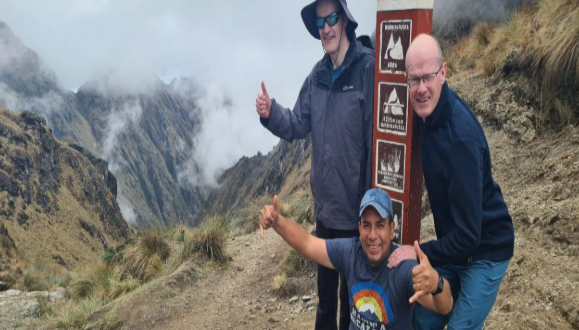Trekking the Inca Trail 4 Days – Explorer Families is often seen as one of the most magical ways to experience Peru’s natural beauty, ancient ruins, and rich culture — but many assume it’s only for hardcore hikers. In reality, with thoughtful planning and the right support, the 4 Day – Inca Trail for Families can become a deeply rewarding and unifying adventure. This article explores how families can succeed on this trek, what to expect day by day, tips to prepare, and finally wrap with a conclusion and FAQs to help you plan your unique family expedition.
Why Choose the 4‑Day Option for Families?
The classic Inca Trail (4 days, 3 nights) is the iconic route that many dream of; it covers about 40–42 km (roughly 26 miles) of stone steps, cloud forest, high passes, and ancient ruins.
For families, this 4‑day route offers a perfect balance of challenge and immersion. Compared to shorter or alternative treks, it allows time to acclimate, slow your pace, savor the scenery, and step into history gradually. The “Explorer Families” variant is typically a version designed with extra flexibility, kid‑friendly pacing, and enhanced support (guides trained for family dynamics, gear assistance, optional porters
While not every family can or should attempt it, for those with moderate fitness, pre‑planning, and children (often age 10 or up, depending on experience), it can become a transformative shared memory.
Sample Day‑by‑Day Itinerary (4 Day – Inca Trail for Families)
Below is a typical itinerary (many operators offer family‑friendly variants) adapted from established routes.
Many family‑tailored treks allow slower pace, extra breaks, and shorter walking segments for younger trekkers. Some operators even offer swaps—parents carry children or children join via mule on harder segments (depending on weight limits and safety).Challenges & Considerations for Families
Altitude & Acclimatization
One of the greatest hurdles is altitude. The trail reaches over 4,200 m, which can cause headaches, nausea, fatigue or worse in sensitive trekkers. It’s critical to allow at least 1–2 days of acclimatization in Cusco or the Sacred Valley before trekking. Some agencies recommend light hikes or rest days before the trek.
Physical Preparation
Children and adults alike should train in advance: hikes, stair climbing, cardio workouts, and carrying small backpacks to build stamina.
Permits & Booking Early
Because the classic Inca Trail is heavily regulated, permits sell out months in advance (especially for family‑friendly dates). February is closed for maintenance.
Guest Comfort & Gear
Kids may need extra rest time, light gear, and safety buffer times. Use of porters to carry heavier loads is almost essential. Many family packages include additional porter or mule service.
Good footwear, layered clothing, high‑quality sleeping bags, rain protection, and sun protection are non‑negotiable. Some operators rent gear like sleeping bags, trekking poles, mats.
Flexibility & Mental Readiness
Be ready to slow pace, adjust daily goals, and even skip or shorten a segment if someone is unwell. The aim is a positive experience, not a heroic finish. Many families cite that allowing buffer days or builtin flexibility made the difference. Also, emotional support—encouragement among family members, small goals, and rewards—goes a long way, especially for younger trekkers.
Crowd & Logistics
While the route is iconic, it can be crowded. Trekking outside peak season or using less‑used campsites (some family versions aim to avoid crowded nights) helpsLogistics matter: early wakeups, timed train transfers, and coordination affect the smoothness of the last day. Expect early starts.
Tips & Hacks for a Smoother Family Trek
- Book far ahead — six to twelve months is not too early, especially to secure family‑friendly permits.
- Use extra porters or donkeys to lighten the load for children.
- Break segments into mini‑missions (reach that cairn, rest at a viewpoint) rather than focusing only on the “end.”
- Carry extra snacks and hydration — kids often tire faster when hungry or dehydrated.
- Bring entertainment — lightweight games, stargazing stories, journals to distract during rest segments.
- Train with kids — mock hikes carrying 4–5 kg packs for multiple hours.
- Monitor everyone’s health daily — altitude symptoms, fatigue, mood.
- Plan buffer time — rest breaks, extra lunch or snack stops.
- Consider a support “sweep” guide who stays behind to help slower hikers.
- Celebrate small milestones — crossing a stream, first Inca ruin, reaching a pass.
Why This Becomes a Family Legend
Walking the Inca Trail 4 Days – Explorer Families gives you more than scenic vistas — it’s a shared narrative. Children grow through challenge; parents reconnect in cups of coca tea and dawn shocks at the Sun Gate. Every stone path, hidden ruin, and wet cloud forest becomes a chapter of your family’s story.
Compared to a rushed tour or remote trek, the slower, guided, immersive 4‑day trail allows curiosity, bonding, and reflection. It’s not just “getting to Machu Picchu” — it’s walking into it together.
Conclusion
The 4 Day – Inca Trail for Families is a demanding but deeply rewarding undertaking. With thoughtful planning, realistic pacing, and family‑friendly supports (extra porters, buffer days, gear assistance), it becomes accessible to many families with moderate fitness and spirit of adventure. The trail not only leads you through stunning Andean landscapes and ancient sites, but also deepens family bonds, builds resilience, and creates memories etched in stone and sky.
If you approach it with flexibility, safety, and emotional support, your family can emerge at Machu Picchu not just having “done a trek,” but transformed by it — together.
FAQs (Frequently Asked Questions)
Q1: What is the minimum age for children on the 4‑day Inca Trail?
A: That depends on fitness, experience, and tour operator policy. Many operators set a minimum of 8 to 12 years old, provided the child is physically prepared and comfortable hiking long hours. Some family routes may allow younger children but only if carried on certain segments.
Q2: Is altitude sickness a serious risk?
A: Yes, especially above ~3,500 m. Headaches, nausea, dizziness can appear. Acclimatization days, hydration, proper rest, and listening to your body are vital. Some families carry altitude‑related medications (consult a doctor).
Q3: How many days before should we arrive in Cusco to acclimate?
A: Ideally 1–2 full days of acclimatization (or more) in Cusco or the Sacred Valley, with light walks and rest, before beginning the trek.
Q4: Can we skip the hardest segments or shorten the route?
A: Some itineraries include alternative shorter segments, or transfer portions by horse or mule. However, official Inca Trail permit routes are fixed, so major skips are rare. Always negotiate with your operator.

